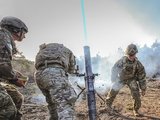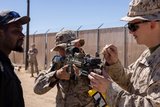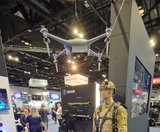US Army soldiers train for large-scale combat operations against CBRN threats
With the US Army's transition from counterinsurgency operations, training rotations now focus on preparing manoeuvre units for large-scale combat. (Photo: US DoD)
The US Army's 2nd ABCT, 3rd Infantry Division, recently completed Decisive Action Rotation 23-05 at the National Training Center (NTC) at Fort Irwin, California, with support from the 92nd Chemical Company (Hazardous Response) and the 756th Ordnance Company (Explosive Ordnance Disposal).
The units honed their skills against opposition forces from the 11th Armored Cavalry Regiment in the Mojave Desert training centre.
The 20th CBRNE Command, comprising soldiers and army civilians from 19 bases across 16 states, provides support for joint, interagency and allied operations, tackling the dangerous hazards.
Related Articles
IVAS programme has made major progress, says US Army Chief of Staff
With the US Army's transition from counterinsurgency operations, training rotations now focus on preparing manoeuvre units for large-scale combat operations against an enemy that could use chemical, biological, radiological and nuclear weapons.
To prepare for the rotation, aircraft decontamination, CBRN detection for a wet gap crossing operation and an integrated command post exercise were undertaken.
‘The 92nd Chemical Company (Hazardous Response) brought mounted and dismounted reconnaissance, detailed troop and equipment decontamination and sensitive site analysis,’ Capt Donovan G Coleman, the commander of the company, said.
The 756th EOD Company provided EOD techs that not only train for combat operations but also take on domestic response missions.
‘Our mission is to protect personnel and property against explosive threats and hazards,’ 1st Sgt Henry J Charles of the 756th EOD Company said. ‘We also provide EOD support to the United States Secret Service for the protection of US and foreign dignitaries.’
The NTC rotation enabled the ‘Blasters’ from the 756th Ordnance Company to integrate and provide continuous support to the 2nd ABCT.
Capt Jose Matos, the commander of the 756th Ordnance Company, said: ‘Our training scenarios were tailored to prepare our Soldiers to support manoeuvre units during large-scale combat operations against a near-peer threat with a heavy emphasis on military munitions to include both foreign and domestic.’
The lessons learned during this NTC rotation will be used to optimize the way the units integrate at the echelon, empower unit leadership, conduct mission-focused training and emphasise the importance of maintenance to build sustainable unit readiness, increase combat power and prepare for their next assigned mission.
More from Training
-
![Cubic tailors mortar simulator for the US Army]()
Cubic tailors mortar simulator for the US Army
The company’s mortar trainer received improvements based on soldier’s feedback.
-
![Saab expands footprint in the US]()
Saab expands footprint in the US
The company will operate in two new locations in the coming years to better support US services.
-
![How terrain management capabilities can improve military training]()
How terrain management capabilities can improve military training
This type of tool provides more realistic training easing the incorporation of new scenarios that accurately represent the threats of the battlefield.
-
![I/ITSEC 2024: Australian Army approaches second phase of countermining training]()
I/ITSEC 2024: Australian Army approaches second phase of countermining training
The Engineering Corps has been conducting individual instruction using FLAIM Systems’ Sweeper and should start collective deployments in 2025.
-
![I/ITSEC 2024: Zeiss introduces Velvet 4K SIM projector for night flight simulation]()
I/ITSEC 2024: Zeiss introduces Velvet 4K SIM projector for night flight simulation
The next-generation platform is motion-compatible and can be used in OTW and NVG applications.
-
![I/ITSEC 2024: Saab introduces UAV live training capability]()
I/ITSEC 2024: Saab introduces UAV live training capability
The system can be used to prepare soldiers for both drone offensive operations and CUAS missions.


























